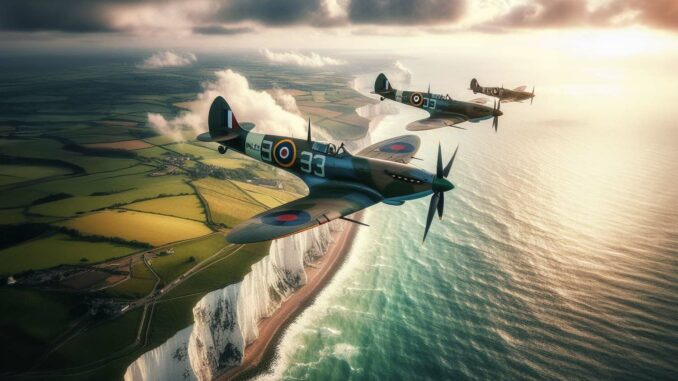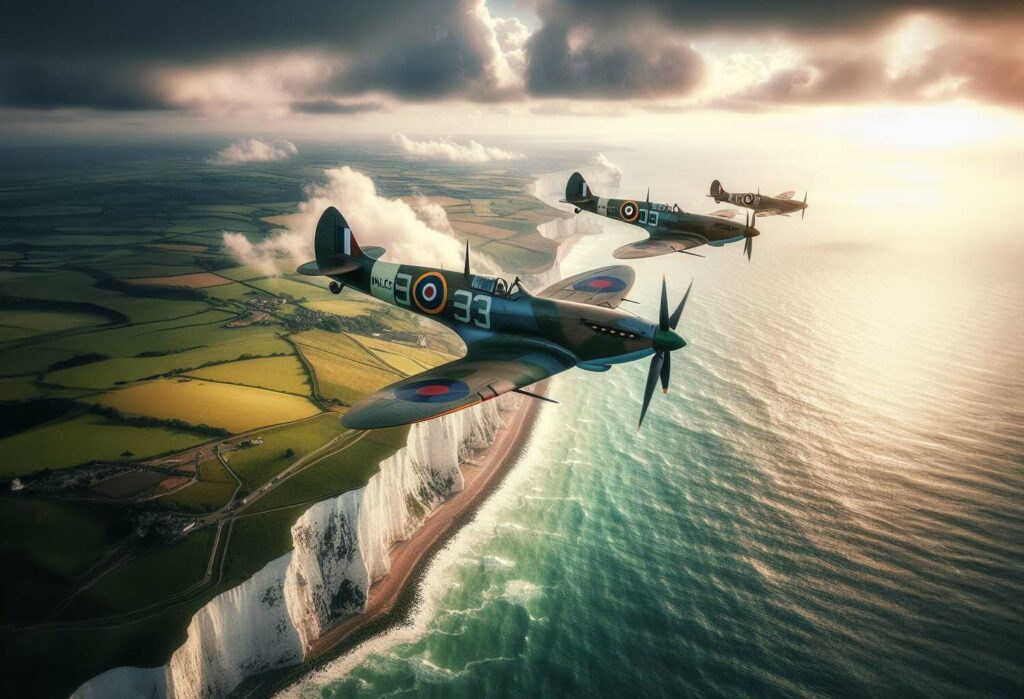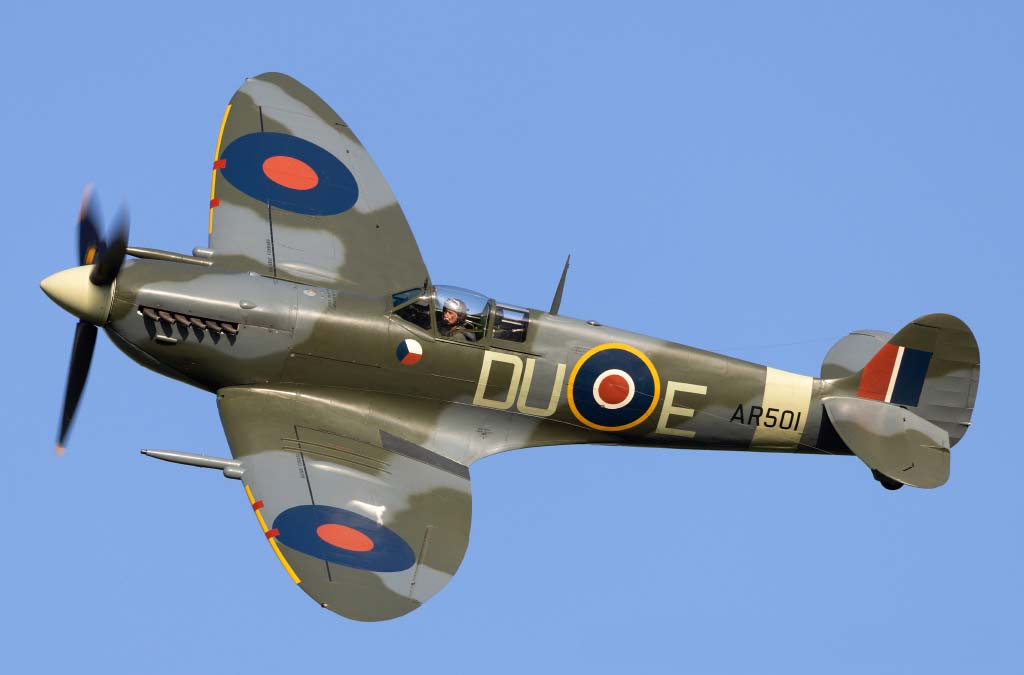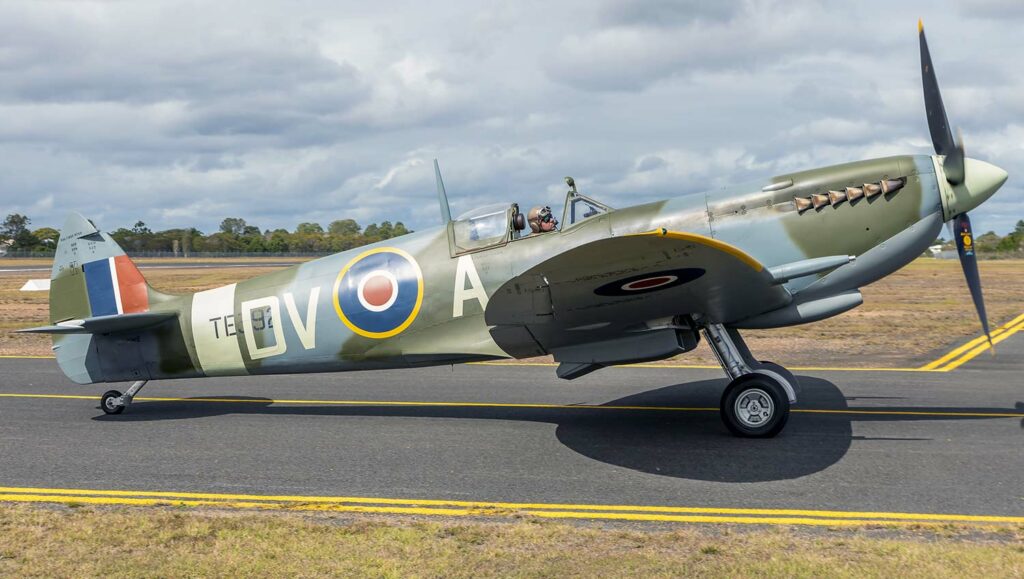
Discover the crucial impact of the Spitfire during the Battle of Britain: its technical advances, strategic role and symbolism in the British resistance.
The Battle of Britain, which took place from July to October 1940, remains one of the most emblematic air battles of the Second World War. In the skies over Europe, the British Royal Air Force (RAF) clashed with the German Luftwaffe in a desperate struggle for air supremacy. This battle was not only a decisive turning point in the war, but also a crucial moment in British history. Indeed, the RAF’s victory thwarted Nazi Germany’s invasion plans, known as Operation Seelöwe (Sea Lion), thus preserving Britain’s independence and security.
At the heart of this battle was the Supermarine Spitfire, a single-seat fighter that quickly became a symbol of British resistance. Designed by engineer R.J. Mitchell, the Spitfire was remarkable for its speed, maneuverability and superior armament, which placed it at the forefront of fighter aircraft at the time. Its elegant silhouette and elliptical wings made it an instantly recognizable icon. More than just an aircraft, the Spitfire embodied the spirit of determination and courage of the British people in the face of adversity.
The Spitfire’s contribution to the Battle of Britain was invaluable. Not only did it play a key role in defending British territory against German bombing, but it also inspired a sense of national pride and resilience. This introduction aims to explore in detail the Spitfire’s technical and symbolic impact, highlighting its crucial role in one of the most important battles in modern history.

Development and technical characteristics of the Spitfire
Design and evolution of the Spitfire
Engineer R.J. Mitchell and the design of the Spitfire
Reginald Joseph Mitchell, born in 1895, was a renowned British aeronautical engineer, best known for designing the Supermarine Spitfire. Mitchell joined the Supermarine Aviation Works in 1916, where he began designing seaplanes and racing aircraft. He became chief designer and engineer at the age of 24. One of his great achievements was winning the Schneider Trophy for Great Britain in 1931 with his revolutionary S series seaplanes, of which the S.6B took the trophy at a speed of 548 Kmh (340mph). These experiences were fundamental to the development of the Spitfire, which began with the Type 224 in 193After its rejection by the Air Ministry, Mitchell revised the design as the Type 300, which evolved into the Spitfire in 1935.
Technical and aerodynamic innovations
The Spitfire was a breakthrough in aeronautical design, mainly due to its continuous development based on the knowledge gained from building racing aircraft. These aircraft were designed in close collaboration with engine suppliers and benefited from access to the best wind tunnel facilities in the UK. These experiences provided Mitchell’s team with invaluable data on high-speed flight and aircraft construction, helping them to design fast interceptors. The Spitfire, the result of this evolution, stood out for its superior speed and aerodynamics, being almost 40 mph faster than its main competitor, the Hawker Hurricane.
Technical comparison with German aircraft
Advantages of the Spitfire over the Messerschmitt Bf 109
The Spitfire had several advantages over the Messerschmitt Bf 109, the leading German fighter of the time. These included better maneuverability, thanks to its elliptical wings and lightweight structure, and better visibility for the pilot. In addition, the Spitfire had a superior rate of climb, which was crucial in the air battles of the Battle of Britain.
Maneuvering and aerial combat capabilities
The Spitfire was renowned for its ability to perform tight, fast maneuvers, which was essential in close air combat. Its speed and agility enabled it to gain the upper hand over enemy aircraft, particularly in tight turns and dives. These characteristics made the Spitfire a formidable opponent in aerial duels, and contributed to its legend as one of the best fighters of the Second World War.

The Spitfire in the Battle of Britain: a decisive weapon
Spitfire missions
Air defense and German bomber interception
During the Battle of Britain, the Spitfire played a crucial role in defending British airspace against Luftwaffe attacks. Its aerodynamic design, efficient armament and great maneuverability made it ideal for intercepting enemy bombers and fighters. Despite the fact that the Hurricanes outnumbered and accounted for the majority of German aircraft shot down, the Spitfire still won 42% of victories against enemy aircraft, demonstrating its effectiveness in aerial combat.
Escorting British bombers
The Spitfire was also used to escort British bombers on their missions. Its speed and ability to operate at high altitude made it an excellent escort fighter, capable of protecting bombers from enemy fighter attacks.
Spitfire pilots
Pilot training and skills
Spitfire pilots were rigorously trained to master complex aerial combat techniques. They were selected for their piloting skills and their ability to handle intense combat situations. The quality of their training, combined with the Spitfire’s exceptional performance, was a key factor in the RAF’s success during the Battle of Britain.
Stories and testimonials from Spitfire pilots
Many Spitfire pilots have shared their experiences and testimonials, often referring to the aircraft’s agility, speed and power. These accounts underline the importance of the Spitfire in the defense of Great Britain, and its contribution to the RAF’s victory over the Luftwaffe. They also illustrate the courage and determination of the pilots who fought in extremely difficult conditions.

Strategic and symbolic impact of the Spitfire
Strategic impact of the Spitfire on the Battle of Britain
Role in preserving British air superiority
The Spitfire played a fundamental role in preserving British air superiority during the Battle of Britain. Although the Hurricanes shot down a greater number of enemy aircraft (55% versus 42% for the Spitfires), the Spitfire’s presence and performance were essential in maintaining the balance of power in the air. Its speed, maneuverability and firepower enabled the Royal Air Force (RAF) to counter Luftwaffe attacks effectively.
Contribution to the failure of Operation Seelöwe
The Spitfire also made a significant contribution to the failure of Operation Seelöwe, the German plan to invade Britain. The Spitfire’s ability to defend British airspace against air assaults was a decisive factor in preventing the establishment of German air supremacy, an essential prerequisite for the invasion. British air resistance, reinforced by the Spitfire, ultimately led to the Germans abandoning Operation Seelöwe.
The Spitfire as a symbol of British resistance
Influence on British morale
The Spitfire quickly became a symbol of resistance and national pride for the British. Its distinctive silhouette and successes against the Luftwaffe boosted morale and symbolized British determination to resist Nazi oppression. The Spitfire embodied British fighting spirit and ingenuity, playing a crucial role in maintaining morale during the darkest moments of the war.
Legacy and legend of the Spitfire in popular culture
The Spitfire has left a lasting legacy and become a legend in popular culture. It is celebrated in numerous films, books, exhibitions and commemorative events. The Spitfire is recognized not only as a masterpiece of aeronautical engineering, but also as a symbol of courage and sacrifice. Its image is deeply rooted in British national identity and continues to inspire future generations.
War Wings Daily is an independant magazine.